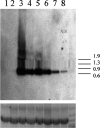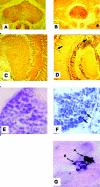Pathogenic chaperone-like RNA induces congophilic aggregates and facilitates neurodegeneration in Drosophila
- PMID: 17441503
- PMCID: PMC1874921
- DOI: 10.1379/csc-222r.1
Pathogenic chaperone-like RNA induces congophilic aggregates and facilitates neurodegeneration in Drosophila
Abstract
Protein aggregation is a hallmark of many neurodegenerative diseases. RNA chaperones have been suggested to play a role in protein misfolding and aggregation. Noncoding, highly structured RNA recently has been demonstrated to facilitate transformation of recombinant and cellular prion protein into proteinase K-resistant, congophilic, insoluble aggregates and to generate cytotoxic oligomers in vitro. Transgenic Drosophila melanogaster strains were developed to express highly structured RNA under control of a heat shock promoter. Expression of a specific construct strongly perturbed fly behavior, caused significant decline in learning and memory retention of adult males, and was coincident with the formation of intracellular congophilic aggregates in the brain and other tissues of adult and larval stages. Additionally, neuronal cell pathology of adult flies was similar to that observed in human Parkinson's and Alzheimer's disease. This novel model demonstrates that expression of a specific highly structured RNA alone is sufficient to trigger neurodegeneration, possibly through chaperone-like facilitation of protein misfolding and aggregation.
Figures





Similar articles
-
Non-coding RNA as a trigger of neuropathologic disorder phenotypes in transgenic Drosophila.J Neural Transm (Vienna). 2008 Dec;115(12):1629-42. doi: 10.1007/s00702-008-0078-8. Epub 2008 Sep 9. J Neural Transm (Vienna). 2008. PMID: 18779919
-
Intraneuronal Abeta, non-amyloid aggregates and neurodegeneration in a Drosophila model of Alzheimer's disease.Neuroscience. 2005;132(1):123-35. doi: 10.1016/j.neuroscience.2004.12.025. Neuroscience. 2005. PMID: 15780472
-
The calcineurin inhibitor Sarah (Nebula) exacerbates Aβ42 phenotypes in a Drosophila model of Alzheimer's disease.Dis Model Mech. 2016 Mar;9(3):295-306. doi: 10.1242/dmm.018069. Epub 2015 Dec 10. Dis Model Mech. 2016. PMID: 26659252 Free PMC article.
-
Chaperones and aging: role in neurodegeneration and in other civilizational diseases.Neurochem Int. 2002 Dec;41(6):383-9. doi: 10.1016/s0197-0186(02)00043-8. Neurochem Int. 2002. PMID: 12213225 Review.
-
Proteostasis and the Regulation of Intra- and Extracellular Protein Aggregation by ATP-Independent Molecular Chaperones: Lens α-Crystallins and Milk Caseins.Acc Chem Res. 2018 Mar 20;51(3):745-752. doi: 10.1021/acs.accounts.7b00250. Epub 2018 Feb 14. Acc Chem Res. 2018. PMID: 29442498 Review.
Cited by
-
Genes Responsible for H2S Production and Metabolism Are Involved in Learning and Memory in Drosophila melanogaster.Biomolecules. 2022 May 26;12(6):751. doi: 10.3390/biom12060751. Biomolecules. 2022. PMID: 35740876 Free PMC article.
-
Non-coding RNA as a trigger of neuropathologic disorder phenotypes in transgenic Drosophila.J Neural Transm (Vienna). 2008 Dec;115(12):1629-42. doi: 10.1007/s00702-008-0078-8. Epub 2008 Sep 9. J Neural Transm (Vienna). 2008. PMID: 18779919
-
3-Hydroxykynurenine as a Potential Ligand for Hsp70 Proteins and Its Effects on Drosophila Memory After Heat Shock.Mol Neurobiol. 2022 Mar;59(3):1862-1871. doi: 10.1007/s12035-021-02704-3. Epub 2022 Jan 14. Mol Neurobiol. 2022. PMID: 35029786
-
Report on the 13th symposium on invertebrate neurobiology held 26-30 August 2015 at the Balaton Limnological Institute, MTA Centre for ecological research of the Hungarian Academy of Sciences, Tihany, Hungary.Invert Neurosci. 2016 Jun;16(2):3. doi: 10.1007/s10158-016-0186-3. Invert Neurosci. 2016. PMID: 27149972
-
Hsp70 affects memory formation and behaviorally relevant gene expression in Drosophila melanogaster.Cell Stress Chaperones. 2021 May;26(3):575-594. doi: 10.1007/s12192-021-01203-7. Epub 2021 Apr 7. Cell Stress Chaperones. 2021. PMID: 33829398 Free PMC article.
References
Publication types
MeSH terms
Substances
LinkOut - more resources
Full Text Sources
Molecular Biology Databases
